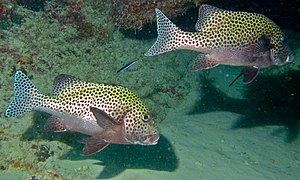
Haemulidae is a family of fishes in the order Perciformes known commonly as grunts. It is made up of the two subfamilies Haemulinae (grunters) and Plectorhynchinae (sweetlips), which in turn contain about 133 species in 19 genera. These fish are found in tropical fresh, brackish, and salt waters around the world. They are bottom-feeding predators, and named for the ability of Haemulinae to produce sound by grinding their teeth. They also engage in mutualistic relationship with cleaner gobies of genus Elacatinus, allowing them to feed on ectoparasites on their bodies.

Sargocentron is a genus of squirrelfish found in tropical parts of the Indian, Pacific and Atlantic Oceans, with the greatest species diversity near reefs in the Indo-Pacific. Being largely or entirely nocturnal, they have relatively large eyes. Red and silvery colours dominate. The preopercle spines are venomous and can give painful wounds. Most have a maximum length of 15–25 cm (6–10 in), but S. iota barely reaches 8 cm (3 in), and S. spiniferum can reach more than 50 cm (20 in).

Plectorhinchus chaetodonoides, the harlequin sweetlips, clown sweetlips, spotted sweetlips or many-spotted sweetlips, is a species of marine ray-finned fish, a sweetlips belonging to the subfamily Plectorhinchinae, one of two subfamilies in the family Haemulidae, the grunts. It is native to the Indo-Pacific region. This species is of minor importance to local commercial fisheries and can be found in the aquarium trade.

The Indian Ocean oriental sweetlips, also known as the oriental sweetlips or oriental blubberlips, is a species of marine ray-finned fish, a sweetlips belonging to the subfamily Plectorhinchinae, one of two subfamilies in the family Haemulidae, the grunts. It is native to the Indian Ocean and the western Pacific Ocean.

Plectorhinchus polytaenia, the ribboned sweetlips, also known as Tesone di mare or yellow-ribbon sweetlips, is a species of marine ray-finned fish, a sweetlips belonging to the subfamily Plectorhinchinae, one of two subfamilies in the family Haemulidae, the grunts. It is native to the Indian Ocean and the western Pacific Ocean.
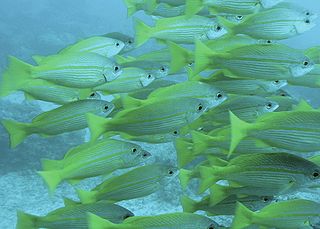
Lutjanus is a genus of marine ray-finned fish, snappers belonging to the family Lutjanidae. They are found in the Atlantic, Indian, and Pacific Oceans. They are predatory fish usually found in tropical and subtropical reefs, and mangrove forests. This genus also includes two species that only occur in fresh and brackish waters.

Plectorhinchus pica, the painted sweetlips, dotted sweetlips, magpie sweetlips or spotted sweetlips, is a species of marine ray-finned fish, a sweetlips belonging to the subfamily Plectorhinchinae, one of two subfamilies in the family Haemulidae, the grunts. It is native to coral reefs of the Indian Ocean and the western Pacific Ocean. It is a commercially important species and can be found in the aquarium trade.

Plectorhinchus diagrammus, the striped sweetlips, fourbanded sweetlips or silver-banded sweetlips, is a species of marine ray-finned fish, a sweetlips belonging to the subfamily Plectorhinchinae, one of two subfamilies in the family Haemulidae, the grunts. It feeds on benthic invertebrates. This species can reach 40 cm (16 in) in TL. It can be found in the aquarium trade and is farmed. It is native to the eastern Indian Ocean and the western Pacific Ocean, from the Andaman Islands to the Philippines, north as far as Japan, where it is an inhabitant of coral reefs. This species was first formally described in 1758 by Linnaeus in the 10th edition of the Systema Naturae, he gave it the name Perca diagramma. Its specific name diagrammus was not explained by Linnaeus but he cites Gronovius in his description who described “irregular longitudinal yellow lines”, so the name is inferred to “a figure marked with lines”.
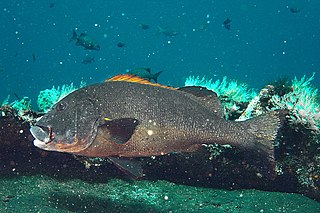
Plectorhinchus albovittatus, the two-striped sweetlips or giant sweetlips, is a species of marine ray-finned fish, a sweetlips belonging to the subfamily Plectorhinchinae, part of the grunt family Haemulidae. It is native to the Indian Ocean and the western Pacific Ocean.

Haemulon is a genus of fish in the grunt family known as the scaled-fin grunts. Most are found in the western Atlantic Ocean, with a few species known from the eastern Pacific Ocean. This genus is considered to be one of the most important fish groups of the coral reefs of Brazil due to its commercial value and crucial ecological role.

Diagramma is a genus of marine ray-finned fishes belonging to the family Haemulidae, grunts native to the Indian Ocean and the western Pacific Ocean. The currently recognized species in this genus are:
Plectorhinchus ceylonensis, the Sri Lanka sweetlips, is a species of marine ray-finned fish, a sweetlips belonging to the subfamily Plectorhinchinae, one of two subfamilies in the family Haemulidae, the grunts. It is native to the Indian Ocean around Sri Lanka. It inhabits waters over coral reefs at depths from 5 to 20 m. This species is rarely found in the aquarium trade.
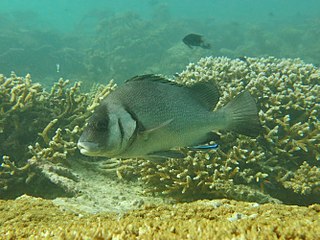
Plectorhinchus gibbosus, commonly known as the Harry hotlips, black sweetlips, brown sweetlips, dusky sweetlips, gibbous sweetlips, hairy hotlips or humpback sweetlips, is a species of marine ray-finned fish, a sweetlips belonging to the subfamily Plectorhinchinae, one of two subfamilies in the family Haemulidae, the grunts. It is native to the Western Pacific and Indian Oceans.
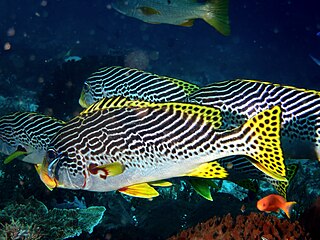
Plectorhinchus lineatus, also known as the yellowbanded sweetlips, oblique-banded sweetlips, diagonal-banded sweetlips, Goldman's sweetlips, lined blubber-lips, lined sweetlips, many-lined sweetlips, striped sweetlips and yellowband sweetlips, is a species of marine ray-finned fish, a sweetlips belonging to the subfamily Plectorhinchinae, one of two subfamilies in the family Haemulidae, the grunts. It inhabits coral reefs of the western Pacific Ocean, where it occurs at depths from 1 to 35 m.

Plectorhinchus caeruleonothus, the blue bastard, is a species of ray-finned fish, a sweetlips belonging to the subfamily Plectorhinchinae, one of two subfamilies in the family Haemulidae, the grunts. It was discovered in Australia in 2015.

Plectorhinchus gaterinus, commonly known as the blackspotted rubberlip or African grunt, is a species of marine ray-finned fish, a sweetlips belonging to the subfamily Plectorhinchinae, one of two subfamilies in the family Haemulidae, the grunts. It is found in the western Indian Ocean.

The sailfin rubberlip is a species of marine ray-finned fish, a sweetlips belonging to the family Haemulidae. It is found in the western Indian Ocean.


